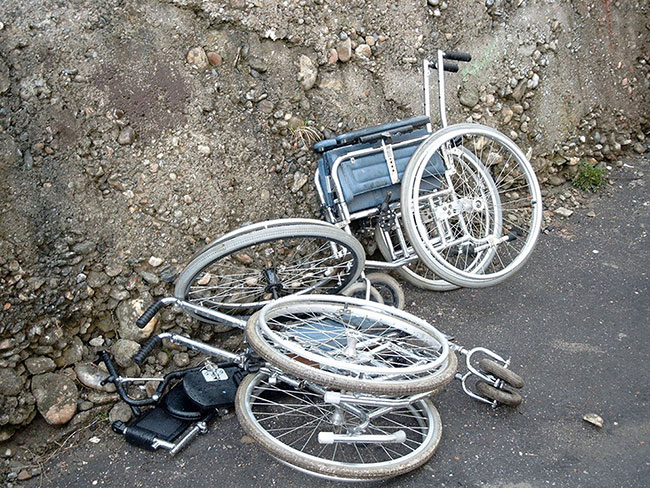People with disabilities are more vulnerable in disasters due to their impairment, existing barriers and lack of information
Following the incessant rainfall since August 11, several southern districts of Nepal have been badly affected, out of which 12 districts are the worst-hit. According to home minister, death toll has reached 131 while more than 80 percent land in Tarai has been submerged and over 9,000 houses damaged as of August 18, resulting in a massive impact on life, livelihood and infrastructure across the 35 affected districts. According to Nepal Red Cross Society, more than 44,000 families are temporarily displaced while over 300,000 families have been affected as Nepal experiences its worst rains in the past 15 years.
The home ministry is leading response efforts. It has instructed all districts to activate District Disaster Relief Committees and initial rapid assessments are already taking place via this mechanism. The government is now welcoming assistance from responsive governments, organizations and interested individuals for support to needy families through coordination with local government mechanisms. It is therefore high time to see things from inclusion lens to ensure that everyone including vulnerable groups such as persons with disabilities can benefit from relief efforts.
Grave risks
People with disabilities are more vulnerable in disasters due to their impairment, existing barriers and lack of information. In times of big disasters, caregiver support will be reduced and people with disabilities are likely to face great difficulty accessing basic essential items such as food, water, shelter, sanitation and healthcare. People with auditory and visual impairments and intellectual disabilities are mostly excluded as they are unaware of what is going on. Studies conducted in the aftermath of the 2015 earthquakes show that people with disabilities were among the most at risk group who had very poor (or no) access to distributed relief material.
Nepal Inclusive Education Summit Convening on December 15

Several post-quake assessments were unsuccessful in including persons with disabilities, and thereby they failed to take a decent overview of their needs. Despite government commitment to various international treaties and conventions there was big gap in the implementation of these instruments during disaster response and recovery phases in 2015 earthquakes and the 2014 flood response in the mid-western region.

The aforementioned facts sufficiently indicate that there is a dire need to ensure disaster response and recovery programs are inclusive and accessible to all people. Here are some steps all humanitarian responders can consider to ensure inclusive response.
One of the key gaps in the disability sector is lack of authentic data source, even in normal situations. Therefore it is high time to start using ‘Washington Group Questions’ to identify proper activities for disabled persons. This tool will help us ask questions that are correct and dignified and help remove barriers for persons with disabilities to access emergency responses such as water and sanitation facilities, food distribution points and health centers.
Include them
Similarly, the importance of participation of persons with disabilities in the planning of emergency response and making decisions in their presence cannot be overemphasized. For that, cluster meetings and other coordination mechanisms at flood-affected districts should ensure participation of persons with disabilities and their representative disabled people’s organizations (DPOs). In order to minimize such risks in the future, communities need to prepare hazard maps and contingency plans in an accessible medium as well as early warning systems to ensure those most at risk are reached.
Considering the difficulties for persons with disabilities in accessing relief packages, humanitarian organizations should prioritize disabled and other vulnerable groups, i.e. elderly, children, pregnant and lactating mothers, as well as people with chronic diseases, while providing basic support such as food, water, shelter, sanitation and healthcare in flood affected communities.
For those individuals who have some injuries and temporary impairments, healthcare and rehabilitation services should be well planned. Those persons with disabilities who lost their devices (i.e. glasses, crutches, wheelchairs, white sticks etc) during the floods should be supplied with lost items immediately as it is crucial to ensure their functional independence. One organization cannot address all these needs and so collaboration among humanitarian actors is highly important.
The government should ensure that at risk groups including people with disabilities are made specific targets of disaster response, as mandated in the Sendai Framework and other national and international instruments. Now that several thousand houses and other infrastructures have been damaged, ‘Universal Design’ theory should be incorporated to ensure public buildings and roads are accessible for disabled persons. The central government needs to support (both technically and financially) newly elected local government bodies in implementing disaster response plans in an inclusive manner.
Lastly, our funding agencies should engage with representatives of people with disabilities and other at- risk groups and prioritize funding projects that ensure execution of inclusive disaster risk management.
The author is associated with Handicap International Nepal. Views expressed are personal
sudarshan.neupane@hotmail.com





































